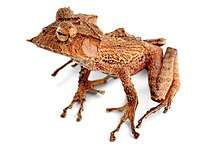Hemiphractus
Hemiphractus is a genus of frogs, the horned treefrogs, in the family Hemiphractidae.[1][2] These overall brownish frogs have a pointed snout and a casque on the head. They are nocturnal, relatively rare and native to humid lowland and highland forests in northern South America (Amazon east as far as Tapajós, Chocó-Magdalena and northern Andes) and Panama, where typically found on the ground or at relatively low levels in vegetation.[1][3][4]
| Hemiphractus | |
|---|---|
 | |
| Hemiphractus bubalus | |
| Scientific classification | |
| Kingdom: | Animalia |
| Phylum: | Chordata |
| Class: | Amphibia |
| Order: | Anura |
| Family: | Hemiphractidae |
| Genus: | Hemiphractus Wagler, 1828 |
| Diversity | |
| See text | |
| Synonyms | |
| |
Description
Hemiphractus are robust-bodied frogs.[5] The genus is characterized by a fleshy proboscis on the tip of the snout and fleshy tubercles on the eyelids, skull that is highly casqued with prominent lateral occipital processes projecting backwards, and fang-like maxillary and premaxillary teeth.[6] Females grow larger than males, and depending on exact species the snout–to–vent length generally is between c. 2.5 and 8 cm (1.0–3.1 in).[3][4]
Behaviour
.jpg)
Hemiphractus are believed to be specialized predators of other frogs, and hence confined to areas with high density of frogs.[7] Nevertheless, they have also been recorded feeding on lizards, large insects and snails in the wild, and in addition to other frogs captive Hemiphractus will eat geckos, newborn mice and earthworms.[3][8]
They can threaten any would-be predator by opening their mouth, exposing the bright yellow inside and tongue.[8][9] If this fails to scare an adversary, they willingly bite, which is relatively painful for a frog of their size.[3]
Female frogs carry eggs openly on their back; the eggs adhere to the mother's back with gelatinous material. Eggs hatch as fully developed froglets.[10] H. elioti (previously included in H. fasciatus) are bred and maintained by the El Valle Amphibian Conservation Center in Panama.[3] Although they have proven relatively difficult to keep in captivity,[11] keeping and breeding has been achieved at levels where its conservation through such measures is considered possible, although (as of 2015 where the total captive population was 36 individuals) additional founders are necessary.[12]
Species
The following species are recognized in the genus Hemiphractus .[1]
- Hemiphractus bubalus (Jiménez de la Espada, 1871)
- Hemiphractus elioti Hill, Martin, Stanley, and Mendelson, 2018
- Hemiphractus fasciatus Peters, 1862
- Hemiphractus helioi Sheil & Mendelson, 2001
- Hemiphractus johnsoni (Noble, 1917)
- Hemiphractus kaylockae Hill, Martin, Stanley, and Mendelson, 2018
- Hemiphractu panamensis (Stejneger, 1917)
- Hemiphractus proboscideus (Jiménez de la Espada, 1871)
- Hemiphractus scutatus (Spix, 1824)
Until 2001, populations now recognized as H. helioi were typically included in H. johnsoni,[6] and until 2018 populations now recognized as H. elioti, H. kaylockae and H. panamensis were typically included in H. fasciatus.[3] Colombian "H. fasciatus" may represent a currently unrecognized species (thus limiting true H. fasciatus to Ecuador),[3] and it is possible that H. scutatus is a species complex.[4]
References
- Frost, Darrel R. (2015). "Hemiphractus Wagler, 1828". Amphibian Species of the World: an Online Reference. Version 6.0. American Museum of Natural History. Retrieved 7 August 2015.
- "Hemiphractidae". AmphibiaWeb: Information on amphibian biology and conservation. [web application]. Berkeley, California: AmphibiaWeb. 2015. Retrieved 7 August 2015.
- Hill, R.L.; K.G. Martin; E. Stanley; J.R. Mendelson III (2018). "A taxonomic review of the genus Hemiphractus (Anura: Hemiphractidae) in Panama: Description of Two New Species, Resurrection of Hemiphractus panamensis (Stejneger, 1917), and Discussion of Hemiphractus fasciatus Peters, 1862". Zootaxa. 4429 (3): 495–512. doi:10.11646/zootaxa.4429.3.3.
- Carneiro de Lima Moraes, J.L..; D. Pavan (2018). "On the occurrence of Hemiphractus scutatus (Spix, 1824) (Anura: Hemiphractidae) in eastern Amazonia". Amphibian & Reptile Conservation. 12 (1): 5–14.
- Vitt, Laurie J.; Caldwell, Janalee P. (2014). Herpetology: An Introductory Biology of Amphibians and Reptiles (4th ed.). Academic Press. p. 497.
- Sheil, C. A.; Mendelson III, J. R. (2001). "A new species of Hemiphractus (Anura: Hylidae: Hemiphractinae), and a redescription of H. johnsoni". Herpetologica. 57: 189–202. JSTOR 3893183.
- IUCN. "IUCN Red List of Threatened Species. Version 2015.2. <www.iucnredlist.org>". Archived from the original on 27 June 2014. Retrieved 12 August 2015.
- Halliday, T. (2016). The Book of Frogs: A Life-Size Guide to Six Hundred Species from around the World. University Of Chicago Press. p. 229. ISBN 978-0226184654.
- Vitt and Caldwell (2014), p. 322
- Vitt and Caldwell (2014), p. 166, 497
- "Individual study: The principles of rapid response for amphibian conservation, using the programmes in Panama as an example". conservationevidence. Retrieved 4 January 2020.
- Gratwicke, B.; et al. (2016). "Evaluating the probability of avoiding disease-related extinctions of Panamanian amphibians through captive breeding programs". Animal Conservation. 19 (4). doi:10.1111/acv.12249.